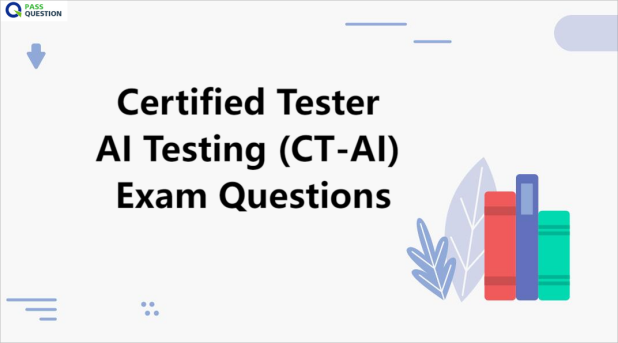Certified Tester AI Testing (CT-AI) Exam Questions
If you are preparing to take the ISTQB Certified Tester AI Testing exam, it's crucial to have the right resources at your disposal. PassQuestion provides high-quality Certified Tester AI Testing (CT-AI) Exam Questions designed specifically to give you the best chance of passing your exam on the first attempt. Each question has been painstakingly crafted by experts in the field, ensuring that they accurately reflect the kinds of questions you will face in the real exam. We strongly recommend using all the Certified Tester AI Testing (CT-AI) Exam Questions as part of your preparation strategy. This will not only give you a comprehensive understanding of the subject matter but will also familiarize you with the exam format and structure. Doing this lets you gain insights into the real exam scenario and understand how best to prepare for the ISTQB Certified Tester AI Testing test.

Certified Tester AI Testing (CT-AI) Exam Overview
The ISTQB AI Testing (CT-AI) certification extends understanding of artificial intelligence and/or deep (machine) learning, most specifically testing AI-based systems and using AI in testing.
The Certified Tester AI Testing certification is aimed at anyone involved in testing AI-based systems and/or AI for testing. This includes people in roles such as testers, test analysts, data analysts, test engineers, test consultants, test managers, user acceptance testers, and software developers. This certification is also appropriate for anyone who wants a basic understanding of testing AI-based systems and/or AI for testing, such as project managers, quality managers, software development managers, business analysts, operations team members, IT directors, and management consultants. To gain this certification, candidates must hold the Certified Tester Foundation Level certificate.
Exam Format
Number of Questions: 40 Questions
Duration: 60 Minutes (+25% Non-Native Language)
Passing Score: 31
Total Points: 47
Pre-requisites: ISTQB Foundation Level Certification
Exam Content
ISTQB AI Testing proves your knowledge in these important AI areas:
- Quality Characteristics for AI-Based Systems
- Machine Learning (ML)
- ML – Data
- ML Functional Performance Metrics
- ML – Neural Networks and Testing
- Testing AI-Based Systems Overview
- Testing AI-Specific Quality Characteristics
- Methods and Techniques for the Testing of AI-Based Systems
- Test Environments for AI-Based Systems
- Using AI for Testing
View Online Certified Tester AI Testing (CT-AI) Free Questions
1. ln the near future, technology will have evolved, and Al will be able to learn multiple tasks by itself without needing to be retrained, allowing it to operate even in new environments. The cognitive abilities of Al are similar to a child of 1-2 years.'
In the above quote, which ONE of the following options is the correct name of this type of Al?
A.Technological singularity
B.Narrow Al
C.Super Al
D.General Al
Answer: D
2. Which of the following is THE LEAST appropriate tests to be performed for testing a feature related to autonomy?
A.Test for human handover to give rest to the system.
B.Test for human handover when it should actually not be relinquishing control.
C.Test for human handover requiring mandatory relinquishing control.
D.Test for human handover after a given time interval.
Answer: B
3. Which ONE of the following options is an example that BEST describes a system with Al-based autonomous functions?
A.A system that utilizes human beings for all important decisions.
B.A fully automated manufacturing plant that uses no software.
C.A system that utilizes a tool like Selenium.
D.A system that is fully able to respond to its environment.
Answer: D
4. Which ONE of the following options does NOT describe a challenge for acquiring test data in ML systems?
A.Compliance needs require proper care to be taken of input personal data.
B.Nature of data constantly changes with lime.
C.Data for the use case is being generated at a fast pace.
D.Test data being sourced from public sources.
Answer: C
5. Which ONE of the following tests is MOST likely to describe a useful test to help detect different kinds of biases in ML pipeline?
A.Testing the distribution shift in the training data for inappropriate bias.
B.Test the model during model evaluation for data bias.
C.Testing the data pipeline for any sources for algorithmic bias.
D.Check the input test data for potential sample bias.
Answer: B
6. Which ONE of the following options describes the LEAST LIKELY usage of Al for detection of GUI changes due to changes in test objects?
A.Using a pixel comparison of the GUI before and after the change to check the differences.
B.Using a computer vision to compare the GUI before and after the test object changes.
C.Using a vision-based detection of the GUI layout changes before and after test object changes.
D.Using a ML-based classifier to flag if changes in GUI are to be flagged for humans.
Answer: A
7. Written requirements are given in text documents, which ONE of the following options is the BEST way to generate test cases from these requirements?
A.Natural language processing on textual requirements
B.Analyzing source code for generating test cases
C.Machine learning on logs of execution
D.GUI analysis by computer vision
Answer: A
8. Which ONE of the following is the BEST option to optimize the regression test selection and prevent the regression suite from growing large?
A.Identifying suitable tests by looking at the complexity of the test cases.
B.Using of a random subset of tests.
C.Automating test scripts using Al-based test automation tools.
D.Using an Al-based tool to optimize the regression test suite by analyzing past test results
Answer: D
- TOP 50 Exam Questions
-
Exam
All copyrights reserved 2025 PassQuestion NETWORK CO.,LIMITED. All Rights Reserved.

